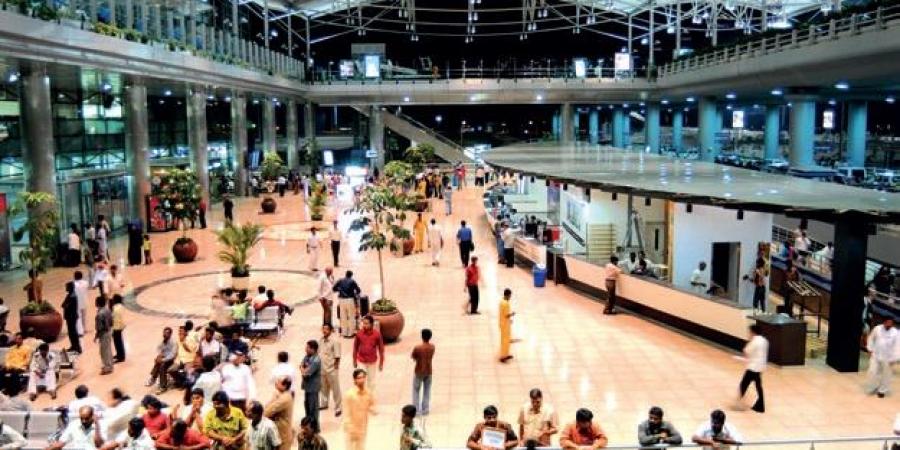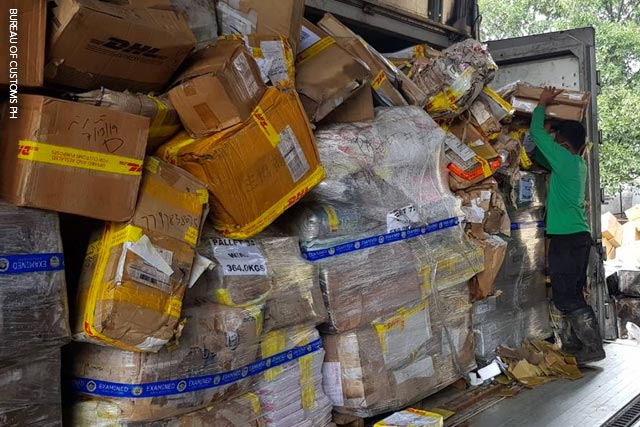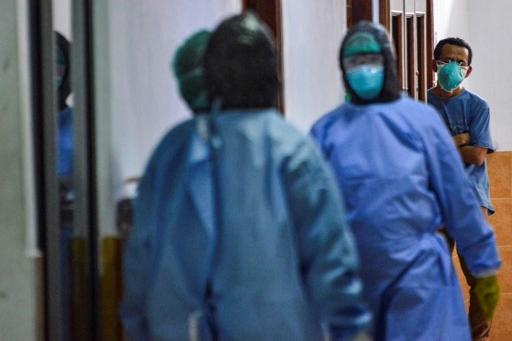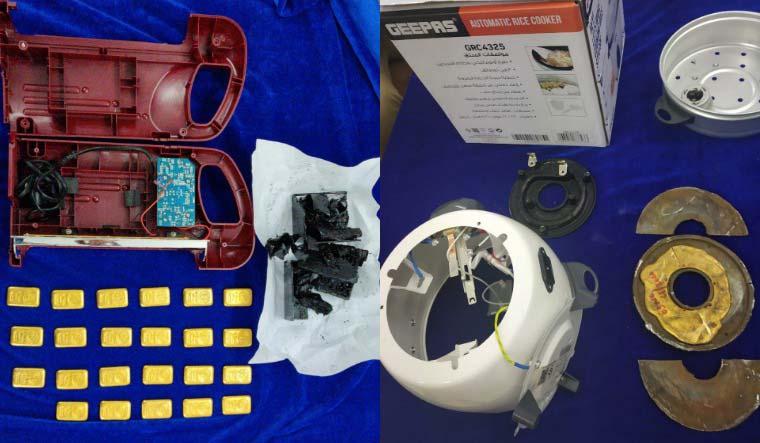
Gold, foreign currency, and cigarettes seized at RGIA.
HYDERABAD: Two persons who arrived at the Rajiv Gandhi International Airport (RGIA) from Delhi were nabbed by the air intelligence officials on Wednesday for attempting to smuggle foreign currency to Dubai through a Delhi-bound flight.
Foreign currency in various denominations equivalent to Rs 16.5 lakh was recovered from them, officials said.
In another case, acting on a specific report, the authorities seized foreign cigarettes illegally being transported into the country. Ten cartons of cigarette packets were seized from 10 passengers who arrived in Hyderabad from different locations including Malaysia, Cambodia, and Dubai. The seized property is worth `50 lakh, officials said.
Authorities seize ₱58 million of fake, smuggled cigarettes.
Metro Manila (CNN Philippines, January 29) – Authorities have seized over P58 million worth of illegal cigarettes in Caloocan City, the Bureau of Customs said Wednesday.
A BOC statement said 1,670 cases of suspected counterfiet and smuggled cigarettes were confiscated by Philippine Coast Guard, Caloocan police and Customs personnel on Tuesday in Barangay 168.
The illegally imported products with supposed brands Marvels, Fortune, D&B, Mighty and Jackpot were stored in nine trucks, BOC said.
The bureau added these brands “are believed to have a big market share in provinces where they are usually sold to unsuspecting patrons.”
Further investigation is being conducted to know who should be held responsible, the bureau said.
https://www.cnnphilippines.com/news/2020/1/29/smuggled-cigarettes-in-Caloocan.html
Lear More
Bureau of Customs seized P20-B smuggled goods in 2019.
The Bureau of Customs (BOC) has seized a total of P20.58 billion-worth of smuggled goods, mostly counterfeit goods, illegal drugs and tobacco products, in 2019.
The BOC said it was able to apprehend P9.44 billion-worth of counterfeit products, P3.59 billion-worth of illegal drugs, and P2.67 billion worth of cigarettes and tobacco products.
The rest are from agricultural goods (P398.47 million), general merchandise (59.87 million), vehicles and accessories (106.55 million), used clothing (P66.86 million), steel products (P78.59 million), electronics (P21 million), goods and firearms (P815,000), currency (P35 million), and other products (P4.1 billion).
They also said their collection efficiency remains consistent at 95.4 percent.
“The collection in 2019, apart from the efforts of our collection districts, is also attributed to revenue collection from issued alert orders amounting to more than P40.9 million; post clearance audits with more than P2 billion collected revenue, and more than P527.9 billion from public auctions,” the BOC said in its report.
https://www.untvweb.com/news/bureau-of-customs-seized-p20-b-smuggled-goods-in-2019/
Lear MoreMan arrested and ‘counterfeit’ cigarettes seized in Ramsgate.
A 39-year-old man wanted on suspicion of malicious communications was arrested in Ramsgate yesterday.
Special constables and officers from the Thanet Community Policing Team attended a property in St Lawrence where they arrested the man and also seized cigarettes suspected to be counterfeit.
Special Constables and Officers from Margate CPT out in Thanet on the hunt for wanted persons. One arrest led to the find of a large quantity of illegal tobacco products.
3 people in total were arrested.
He was taken to custody while enquiries continue. Trading Standards will be notified of the seized goods. A further two people were also arrested during the patrol.
Foreign cigarettes worth Rs. 6 lakh seized, two held.
Hyderabad: The sleuths of Central Zone Task Force along with the Gopalapuram police on Friday arrested two suspects and seized 12 boxes of foreign cigarettes, three cell mobile phones, and cash Rs. 700 all worth Rs. 6 lakh from their possession.
The accused has identified as G Venkatesh (40) resident of Malkajgiri and E Praveen (25) resides in Chilkaguda, tip off, the police nabbed them at parking area of the Secunderabad Railways Station when they were trying to transport the land in a train.
The arrested people along with the seized material were handed over to Gopalapuram police for further investigation.
https://www.siasat.com/foreign-cigarettes-worth-rs-6-lakh-seized-two-held-1804281/
Lear MoreDRI seizes smuggled gold, silver, cash worth Rs 6.42 cr.
Kolkata, Jan 25 (IANS) In a multi-pronged operation, Directorate of Revenue Intelligence sleuths have busted a smuggling syndicate and seized over 10 kgs of smuggled gold, around 429 kgs of silver and Rs 20.16 lakhs in cash with the total value of the seizure reaching Rs 6.42 crore.
Two persons were arrested, a DRI official said on Saturday.
Acting on intelligence inputs that a syndicate under the control of one Anurag Jalan was actively involved in smuggling of gold in biscuit form from Bangladesh through the Indo-Bangladesh border in 24 Parganas North district, which they melted and changed into bar form. The DRI sleuths searched three premises in central Kolkata”s Burrabazar on Thursday.
Jalan and one of his staff have been arrested under the provisions of the Customs Act.
In the course of the search at Jalan Bullion and Jewellers on 43 Nalini Seth Road 23 HDPE (High-density polyethylene) and cotton bags containing white coloured silver granules of foreign origin, 505 pieces of mixed white coloured coins of different shapes and sizes made of silver of foreign origin, 20 yellow coloured metallic coins made of smuggled gold of foreign origin and Rs.20, 16,100 in Indian currency – believed to be the sale proceeds of smuggled gold – were seized.
https://www.outlookindia.com/newsscroll/dri-seizes-smuggled-gold-silver-cash-worth-rs-642-cr/1717641
Lear MoreFake currency notes worth Rs 1.06 lakh seized in Odisha, 1 arrested.
A man deposited 53 fake notes of Rs 2,000 in a bank in Cuttack and then complained that the money was not transformed in his account. Fake currency notes worth Rs 1.06 lakh seized in Odisha, 1 arrested
The Cuttack police on Wednesday seized fake currency worth Rs 1.6 lakh in Rs 2,000 denominations which was deposited into a cash deposit machine at CDA township. The depositor has been arrested and being questioned.
Satyajit Panda of Tangi area in Cuttack had deposited 53 counterfeit currency notes of Rs 2,000 denominations in a cash deposit machine of SBI in Markat Nagar area on January 17. Later, he lodged a complaint with the bank saying that the amount was not deposited in his bank account.
However, on January 20 the bank found that all the currency notes deposited by the said depositor were fake currencies. The police were informed and the depositor Satyajit was booked under sections 489 A and 489 C of the IPC by Markat Nagar police.
Italian Police Seize 1 Million Liters of Counterfeit Wine.
Italian police seized over one million liters of counterfeit wine during a series of dawn raids in the northern region of Lombardy. Five were arrested in connection with the production of fake Oltrepò Pavese DOC and PGI wines, Meininger’s Wine Business International reports.
The confiscated bottles contained extra sugar, prohibited grape varieties, and additives to mimic the flavor and aroma of real Oltrepò Pavese wines. Numerous cases were also falsely labeled “organic.” The resulting product was not harmful, according to prosecutors, “just fraudulent.”
The raid was the culmination of a year-long investigation into the Cantina di Canneto wine cooperative, which is located about 35 miles south of Milan, in the Oltrepò Pavese region.
After receiving a tip-off about the co-op’s 2018 vintage, police bugged phones and used video surveillance to obtain the necessary evidence to make their move. It’s currently unknown whether any of the counterfeit wine was exported.
Several high-profile figures were among those arrested, including the Cantina di Canneto cooperative’s chairman, and the vice-chair of the local branch of Assoenologi, Italy’s winemaker’s association.
https://vinepair.com/booze-news/italian-police-counterfeit-wines/
Lear More
Seven million counterfeit cigarettes seized by police in Limburg
Special units of the federal police seized seven million counterfeit cigarettes during a raid in Lanaken on Monday afternoon.
Assisted by members of the Limburg Special Assistance Unit-Tactical intervention group, the special units raided two industrial sheds- one in Smeermaas and one in Gellik- in part of a major investigation into cigarette fraud.
Having recently discovered the storage sites for the counterfeit cigarettes, Genk customs requested that police raids take place, as there was reason to believe that the storage sites would be guarded by armed men, Het Belang Van Limburg explains.
Although the special units did not find anybody in the sheds during the raids, they discovered and seized the seven million counterfeit cigarettes, spokesperson for the Federal Public Service Finance, Customs and Excise, Francis Adyns, confirmed to Het Nieuwsblad. The counterfeit cigarettes were of the Superking brand, mainly consumed in the U.K.

Chennai: Gold worth Rs 1.54 crore seized from juicer, cooker, emergency light.
The Air Intelligence Unit of the Customs seized nearly 4kg of gold, valued at Rs 1.54 crore, in three separate incidents at the international airport in Chennai on Sunday and Monday. The gold was smuggled in an emergency light, rice cooker and electrical juicer, a press release from the Customs revealed.
On Sunday morning, Sharafudheen, a 23-year-old man who arrived via an IndiGo flight from Dubai, was stopped at the exit of the airport. When Customs personnel inspected his checked-in bag, a rice cooker was found. When dismantled, the the rice cooker was found to contain a ring-shaped gold ingot weighing 610gm, worth Rs 25.22 lakh, inside its heating plate. Sharafudheen, a native of Kozhikode, Kerala, was arrested.
On Sunday night, Abdul Jaleel, another native of Kozhikode, was intercepted at the exit of the Chennai Airport. Jaleel, who arrived from Abu Dhabi via Bahrain on a Gulf Air flight, was carrying an electrical juicer. When Customs officials dismantled the juicer, they found a rectangular gold sheet weighing 438gm and valued at Rs 18.11 lakh. The gold sheet was concealed inside the motor of the juicer. Abdul Jaleel is 29 years old.



